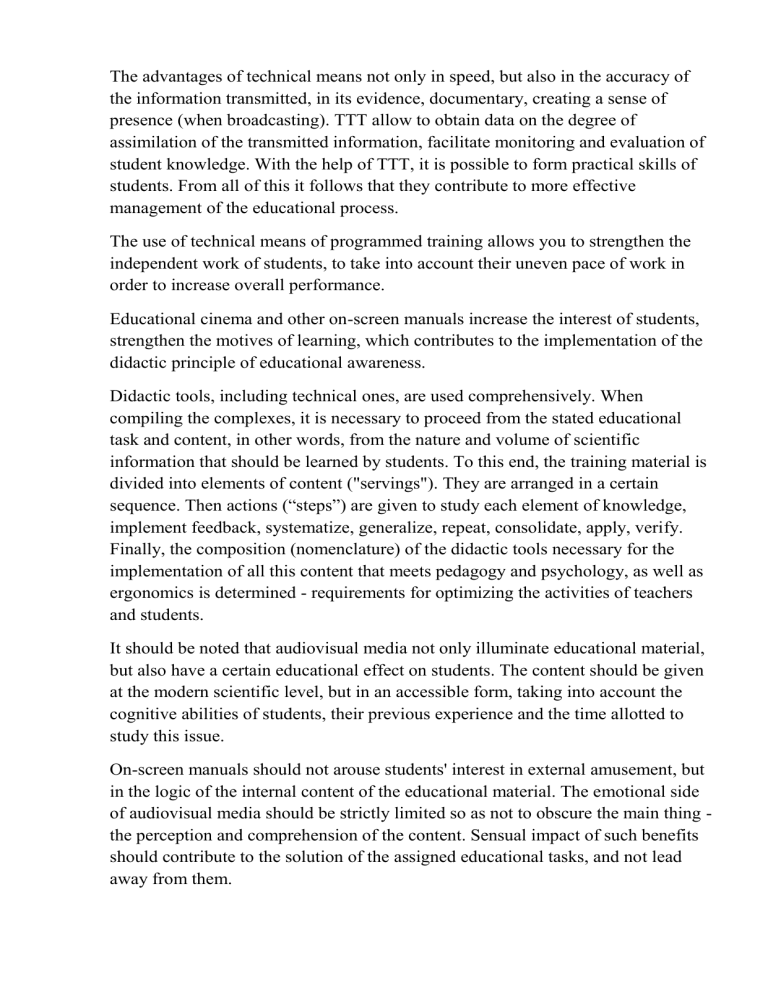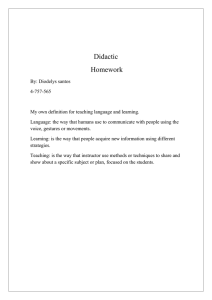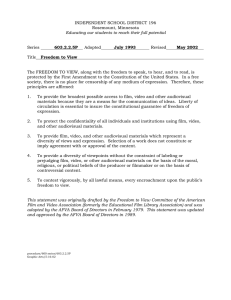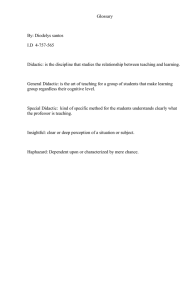
The advantages of technical means not only in speed, but also in the accuracy of the information transmitted, in its evidence, documentary, creating a sense of presence (when broadcasting). TTT allow to obtain data on the degree of assimilation of the transmitted information, facilitate monitoring and evaluation of student knowledge. With the help of TTT, it is possible to form practical skills of students. From all of this it follows that they contribute to more effective management of the educational process. The use of technical means of programmed training allows you to strengthen the independent work of students, to take into account their uneven pace of work in order to increase overall performance. Educational cinema and other on-screen manuals increase the interest of students, strengthen the motives of learning, which contributes to the implementation of the didactic principle of educational awareness. Didactic tools, including technical ones, are used comprehensively. When compiling the complexes, it is necessary to proceed from the stated educational task and content, in other words, from the nature and volume of scientific information that should be learned by students. To this end, the training material is divided into elements of content ("servings"). They are arranged in a certain sequence. Then actions (“steps”) are given to study each element of knowledge, implement feedback, systematize, generalize, repeat, consolidate, apply, verify. Finally, the composition (nomenclature) of the didactic tools necessary for the implementation of all this content that meets pedagogy and psychology, as well as ergonomics is determined - requirements for optimizing the activities of teachers and students. It should be noted that audiovisual media not only illuminate educational material, but also have a certain educational effect on students. The content should be given at the modern scientific level, but in an accessible form, taking into account the cognitive abilities of students, their previous experience and the time allotted to study this issue. On-screen manuals should not arouse students' interest in external amusement, but in the logic of the internal content of the educational material. The emotional side of audiovisual media should be strictly limited so as not to obscure the main thing the perception and comprehension of the content. Sensual impact of such benefits should contribute to the solution of the assigned educational tasks, and not lead away from them. The use of didactic tools in chemistry is due to the methodology of the lesson. Therefore, the sections of this manual devoted to teaching methods gave instructions on the use of "visual aids" and their combination in the educational process. But the methodology of using didactic tools requires special consideration due to the complexity and specificity of this issue. The presence of audiovisual laboratories at the school allows us to differentiate and individualize the educational process in the lesson and extracurricular activities. Thus, TTTs contribute to the implementation of modern concepts of organization of educational work at school. Lessons using TTT can proceed in different ways, for example, from word to view, when a teacher prepares students to perceive a film, they memorize or fix on paper questions that need to be clarified; another way is also possible - from viewing to generalization, when the teacher organizes observation and then generalizes what students have learned when watching the film. The choice of the methods themselves is determined by various factors, among which the most important are the didactic tasks posed in the lesson, the content of training, the specific conditions in which the school operates. Technical means are used in the implementation of all teaching methods: explanatory, illustrative, partially search and research. They make these methods more effective, create new forms of study of the material, positively affect the leadership of the teacher and the cognitive activity of students. Conducting lessons using educational television has its own characteristics. This raises the problem of coordinating the activities of the teacher and the “television teacher”, the narration text and the titles of the on-screen manuals shown, various sources and different forms of presentation of information during the transmission. It is not easy for a school teacher to find his place in this stream of diverse information. In on-screen manuals, the content and construction of information has already been given in advance, they cannot be changed (it is possible to adapt to one degree or another based on specific conditions). This is the well-known difficulty of the methodically correct use of screen didactic tools. To overcome this difficulty, you need to properly prepare students for perception. To this end, precisely determine the educational material that will be revealed in the film, coordinate the content of the film with the knowledge and skills that the students already possess and which serve for the new add-on, provide a form of combining transmission with possible options for students to work independently (time of showing a movie fragment or after watching the entire film, for example, such as performing laboratory experiments, solving problems, etc.), they think through the nature of the subsequent work on the film material - immediately after viewing pa and after a certain time. The technique and technique for demonstrating chemical experiments in the usual way and by projecting them onto the screen are not the same. Requires the fact that the use of on-screen manuals increases educational information in a visual form. The flow of information comes from the screen more intensively than in a regular lesson, and the possibilities to check learning, to establish feedback are relatively limited. Hence the importance of not only proper preparation for watching the film, but also the final conversation, verification of assimilation of what he saw immediately after watching and in subsequent classes. The inclusion of on-screen manuals in the lesson can change its usual structure with a division into the stages of studying new material, consolidating, applying knowledge. When using a movie in a lesson, the teacher’s freedom of maneuver becomes limited. This happens because a film (for example, a review film) can occupy almost the entire lesson, absorbing its individual stages and modifying the surviving ones. Nevertheless, such review films along with fragmentary ones should be used in the educational process. When preparing audiovisual media for use, the teacher carries out preliminary work in the following areas: The analysis of the content of educational material is carried out in order to identify which concepts, laws, theories, facts, objects, phenomena should be presented in a particular manual, which topics should be emphasized, where it is necessary to establish links between them. Appropriate teaching methods for teaching are selected - the transfer of readymade knowledge, search, research approaches; use of induction and deduction; organization of students during the use of audiovisual means - frontal, group, individual work; exercises, laboratory experiments are selected. The didactic tools necessary for the implementation of the intended content using appropriate methods are selected. Screen tutorials are determined for the lesson, the necessary images are selected from a series of transparencies, fragments and individual frames of films and transparencies are noted. They also make the selection of other didactic means: natural objects, instruments, models, tables, etc. All this opens up exclusively promising opportunities for a new technical tool for demonstrating a chemical experiment. Questions for self-control: 1. Appointment of instruments and installations in the school`s chemistry office. 2. What are the rules of working with gases? 3. Describe the methodological and technical foundations of the relationship of a chemical experiment with TTT. Recommended literature: 1. Чернобельская Н.М. Методика обучения химии в средней школе. М. Владос, 2000. 2. Зайцев О.С. Методика обучения химии.М.: Владос, 1999. 3. Программа по химии для 8- 9 кл. Каз.акад.образ. им.Ы.Алтынсарина.2004. 4. Программа по химии для 10,11 кл. Каз.акад.образ. им.Ы.Алтынсарина.2006. 5. Концепция химического образования в школе. Алматы, 2006.



